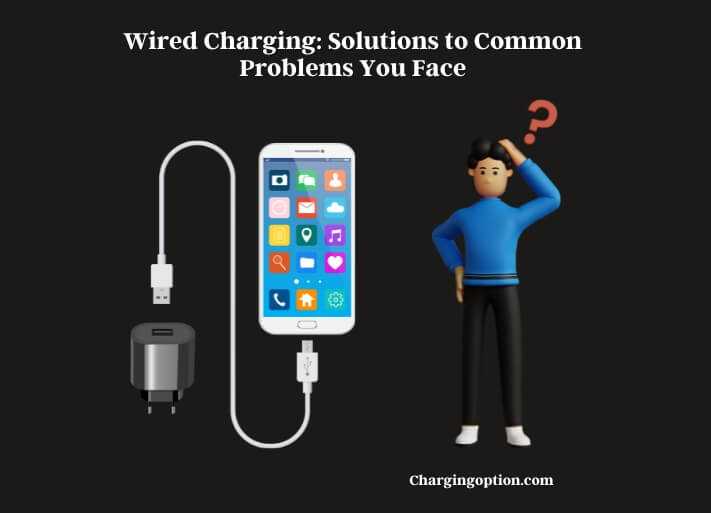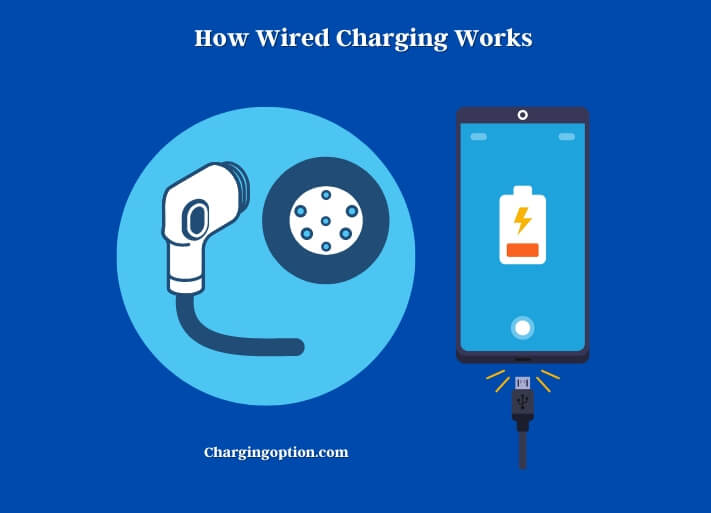Wired charging has a long and fascinating history, dating back to the early days of electrical engineering. While the technology has evolved considerably over the years, the basic principles of wired charging remain the same.

Today, wired charging is a ubiquitous feature of modern life, with a wide range of charging standards and technologies available to suit different devices and use cases. With advances in technology, we are witnessing a new era of wired charging that promises even faster charging speeds, greater compatibility, and improved battery health.
Types of Wired Charging
Wired charging refers to the process of charging a device using a physical connection between the device and the charging source. Here are some common types of wired charging:
USB-A
This is a common type of wired charging that uses a USB-A cable to connect the device to a charging source, such as a computer or a wall adapter.
USB-C
This is a newer type of wired charging that uses a USB-C cable to connect the device to a charging source. USB-C is becoming more popular due to its higher power output and faster charging speeds.
Lightning
This is a proprietary wired charging technology used by Apple devices, including iPhones, iPads, and iPods. Lightning cables have a unique connector that only works with Apple devices.
Micro-USB
This is an older type of wired charging that uses a micro-USB cable to connect the device to a charging source. Micro-USB is still used by some older Android devices and other electronics.
Magnetic Charging
Some devices, such as the Apple Watch, use magnetic charging technology. The charging cable attaches magnetically to the device, making it easy to connect and disconnect.
How Wired Charging Works
Wired charging is a process that involves the transfer of electrical energy from a power source to a device through a physical connection. The power source can be a wall outlet, a USB port on a computer or other device, or a dedicated charging station.

The charging process begins when the device is connected to the power source using a cable. The cable acts as a conduit for the electrical energy to flow from the power source to the device. The cable is usually a USB cable, although other types of cables are also used for specific devices, such as the Lightning cable for Apple products.
Once the device is connected to the power source, the charging process begins. The power source sends an electrical current through the cable to the device, which charges the battery. The rate of charging depends on the voltage and amperage of the power source, as well as the charging capacity of the device’s battery.
One of the most significant advantages of wired charging is that it allows for fast and efficient charging of electronic devices. This is because wired charging can deliver higher amperage and voltage levels than wireless charging, resulting in faster charging times.
There are also some limitations to wired charging. One issue is that cables can become damaged over time, resulting in slower charging speeds or a complete loss of charging capability.
Another issue is that the charging speed is limited by the capacity of the charging cable, and not all cables are created equal. It’s essential to use high-quality cables that are compatible with your device and power source for optimal charging performance.
Common Wired Charging Issues
While wired charging is a reliable and efficient way to charge your electronic devices, there are some common issues that can arise. These issues can include charging speed limitations, heat generation, and compatibility issues.
Charging Speed Limitations
One of the main limitations of wired charging is that the charging speed is limited by the charging capacity of the device’s battery and the charging cable. Different cables have different charging capacities, and not all devices can handle high charging speeds. Charging speed may slow down as the battery approaches full capacity to prevent overheating.
Heat Generation
Wired charging can generate heat, which can affect the performance of the device and the charging cable. This can happen when the charging cable and/or the device are exposed to high temperatures, or when the charging process generates a lot of heat. Heat can damage the battery or other components of the device, resulting in reduced battery life and performance.
Compatibility Issues
Wired charging can be limited by compatibility issues between the charging cable, the device, and the power source. Incompatible cables or power sources may result in slow charging speeds, damaged devices or cables, or even complete failure of the charging process.
Cable Damage
Another common issue with wired charging is cable damage. Over time, cables can become frayed, bent, or otherwise damaged, which can affect the charging performance and even lead to a complete failure of the charging process. This is why it’s important to use high-quality charging cables and handle them with care to prevent damage.
Overcharging
Overcharging is another common issue with wired charging, which can occur when a device is left plugged in for an extended period after the battery is fully charged. Overcharging can lead to reduced battery life and performance, as well as other issues such as overheating and damage to the battery or device.
Power Source Issues
Power source issues can also affect wired charging, such as using an incompatible or low-quality power source. This can lead to slower charging speeds, inconsistent performance, or even damage to the device or charging cable. It’s important to use a high-quality power source that is compatible with your device and charging cable for optimal charging performance.
Wired Charging Standards
Wired charging standards refer to the different types of charging technologies and protocols used in the charging process. There are several wired charging standards available, each with its own advantages and limitations.
USB Charging
USB charging is one of the most common wired charging standards and is used for a wide range of electronic devices, including smartphones, tablets, and laptops. USB charging delivers power through a USB cable that connects the device to a power source such as a wall adapter or computer.
Lightning Charging
Lightning charging is a proprietary wired charging standard developed by Apple for its products. Lightning charging uses a Lightning cable to transfer power from the power source to the device.
USB-C Charging
USB-C charging is a newer wired charging standard that offers faster charging speeds and greater compatibility with a range of devices. USB-C cables have a reversible connector, making them easier to plug in and use, and can deliver up to 100 watts of power.
Quick Charge
Quick Charge is a wired charging standard developed by Qualcomm that allows devices to charge faster using compatible power sources and cables. Quick Charge technology is available in several versions, with each offering faster charging speeds than the previous one.
Power Delivery
Power Delivery is another wired charging standard that allows for faster charging speeds and greater compatibility with a range of devices. Power Delivery technology can deliver up to 100 watts of power and supports a range of voltage and amperage levels to optimize charging performance.
Future of Wired Charging
As technology continues to evolve, wired charging is also evolving to meet the changing needs of consumers. Here are some of the trends and innovations that are shaping the future of wired charging:
Higher Power Delivery: One of the main trends in wired charging is the development of higher power delivery systems that can charge devices faster and more efficiently. This includes technologies like USB-C and Power Delivery, which offer faster charging speeds and greater compatibility with a range of devices.
Wireless Charging Integration: While wired charging remains the most common method of charging electronic devices, wireless charging is becoming increasingly popular. In the future, we may see more devices that integrate both wired and wireless charging capabilities, allowing users to charge their devices in whichever way is most convenient for them.
Enhanced Safety Features: Safety is always a concern when it comes to charging electronic devices. To address this, we may see more wired charging systems with enhanced safety features such as automatic shut-off when the battery is full or protection against power surges and overheating.
Universal Charging Standards: As the number of different charging standards continues to grow, there may be a move towards more universal charging standards that are compatible with a wide range of devices. This could simplify the charging process for consumers and reduce the need for multiple charging cables and adapters.
Integration with Smart Home Technology: As smart home technology continues to advance, we may see more wired charging systems that are integrated with smart home devices and networks. This could allow for more convenient charging and greater control over the charging process.
Conclusion
Wired charging remains the most common and reliable method of charging electronic devices, with several charging standards available to meet the different needs of consumers. While wireless charging is becoming increasingly popular, wired charging still offers faster charging speeds and greater compatibility with a wider range of devices.
As technology continues to evolve, we can expect to see continued innovation in the wired charging space, with higher power delivery systems, enhanced safety features, and more universal charging standards. We may see more devices that integrate both wired and wireless charging capabilities, allowing for more convenient charging options for users.
When choosing a wired charging system, it’s important to consider the compatibility of the charging cable and power source with your device and the desired charging standard. By selecting high-quality cables and power sources that are compatible with your device, you can ensure optimal charging performance and avoid common charging issues such as slow charging or damage to the device battery.
